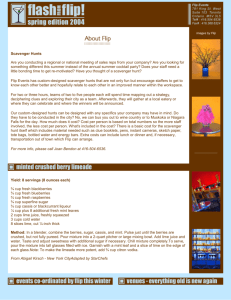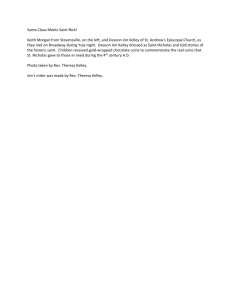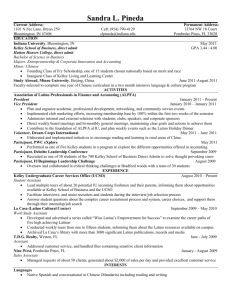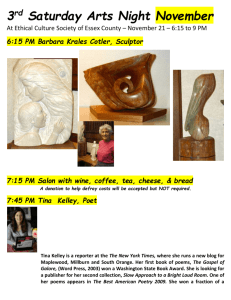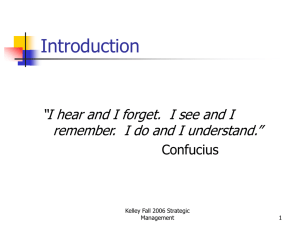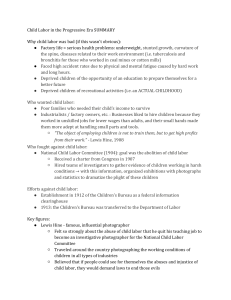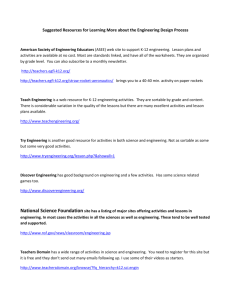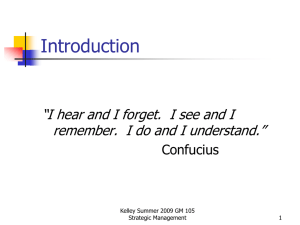The ART of Innovation (Keeley 2001)
advertisement
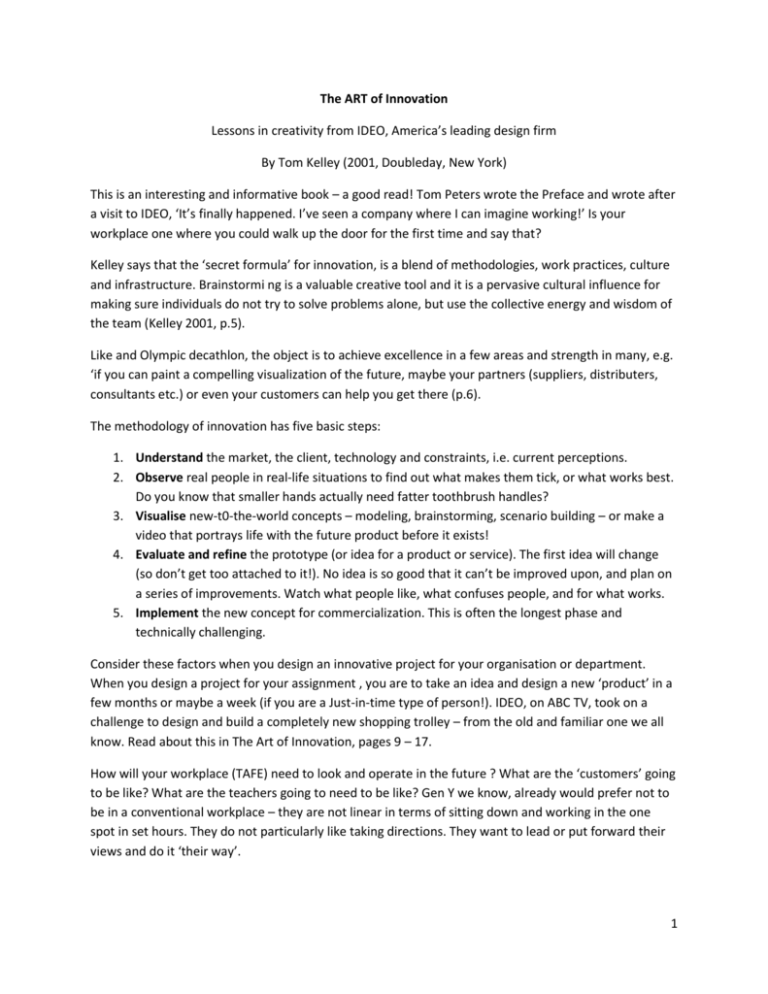
The ART of Innovation Lessons in creativity from IDEO, America’s leading design firm By Tom Kelley (2001, Doubleday, New York) This is an interesting and informative book – a good read! Tom Peters wrote the Preface and wrote after a visit to IDEO, ‘It’s finally happened. I’ve seen a company where I can imagine working!’ Is your workplace one where you could walk up the door for the first time and say that? Kelley says that the ‘secret formula’ for innovation, is a blend of methodologies, work practices, culture and infrastructure. Brainstormi ng is a valuable creative tool and it is a pervasive cultural influence for making sure individuals do not try to solve problems alone, but use the collective energy and wisdom of the team (Kelley 2001, p.5). Like and Olympic decathlon, the object is to achieve excellence in a few areas and strength in many, e.g. ‘if you can paint a compelling visualization of the future, maybe your partners (suppliers, distributers, consultants etc.) or even your customers can help you get there (p.6). The methodology of innovation has five basic steps: 1. Understand the market, the client, technology and constraints, i.e. current perceptions. 2. Observe real people in real-life situations to find out what makes them tick, or what works best. Do you know that smaller hands actually need fatter toothbrush handles? 3. Visualise new-t0-the-world concepts – modeling, brainstorming, scenario building – or make a video that portrays life with the future product before it exists! 4. Evaluate and refine the prototype (or idea for a product or service). The first idea will change (so don’t get too attached to it!). No idea is so good that it can’t be improved upon, and plan on a series of improvements. Watch what people like, what confuses people, and for what works. 5. Implement the new concept for commercialization. This is often the longest phase and technically challenging. Consider these factors when you design an innovative project for your organisation or department. When you design a project for your assignment , you are to take an idea and design a new ‘product’ in a few months or maybe a week (if you are a Just-in-time type of person!). IDEO, on ABC TV, took on a challenge to design and build a completely new shopping trolley – from the old and familiar one we all know. Read about this in The Art of Innovation, pages 9 – 17. How will your workplace (TAFE) need to look and operate in the future ? What are the ‘customers’ going to be like? What are the teachers going to need to be like? Gen Y we know, already would prefer not to be in a conventional workplace – they are not linear in terms of sitting down and working in the one spot in set hours. They do not particularly like taking directions. They want to lead or put forward their views and do it ‘their way’. 1 Like the e-commerce revolution twenty-plus years later, it is a time when being old and wise isn’t much of an advantage. You have to track down sources that can help you, and be bold enough to make some educated guesses. ‘When you are stuck with a tough decision or a problem you don’t understand, talk to all the smart people you know’ (Kelley 2001, p.19). It’s the networking approach to problem solving. Have fun, take (calculated )risks, don’t necessarily follow the rules – change them , just ‘wing it’, ‘taste the food’ you make. Seize an opportunity. Kelley suggests being a keen observer and keeping a ‘bug list’. Don’t just write off something which isn’t working. Use the ‘bug list’ to turn minor failings into improvements for your organisation. When you have an idea or newly designed product, don’t ask the customer who is happy with the current one and can’t think of any improvements (they are not visionaries), ask those who have ‘an eye’ for it, those who understand the new product and who will try it out. You learn more from the person who takes a shortcut, forces the product to do something the manual says it can’t, someone who imagines – and breaks the rules! ‘New ideas come from seeing, smelling, hearing – being there’ (p.31). Even with all our information and communication technology, sensory immersion is why people fly around the country and around the world for face-to-face meetings. Phone and videoconferencing often ‘doesn’t do it’! ‘If you are not in the jungle, you’re not going to know the tiger’ (p.31). This is why people still go to galleries and museums, when they could just look at the digital image in their own homes. Other ideas to innovate: Cross-polinate – This is something that strikes you out-of-the-blue, or can you plan for it. It is both passive and active. To make this part of your workplace (pp.159-162): o Subscribe to surf i.e. internet surfing or ‘idea wading’. o Play director – watch people performing small tasks o Hold an open house – invite others, provide food1 o Inspire advocates – while racial land cultural diversity is important, mental diversity is just as important ie. collaborate viewpoints o Hire outsiders – fresh blood, new ideas o Change hats – get out of your own shoes o Cross-train – learn from other industries, both innovative ones and ones who are noncompetitive. o Recognise barriers and build bridges – ‘in the stream of innovation, many companies make the mistake of building dams instead of doing everything possible to increase the flow’ (open the floodgates)(p.179 ). Table pp.180 - 181 shows a creativity checklist of barriers and bridges (a pilot never takes off before running through a checklist!). o Skill sets – it is not always hard to learn new skills e.g. ‘there has long been a certain magic between the cocktail napkin and business plans’ (p,181). o Good design is about meeting people. It is about opening doors. It is like a handshake to make you feel more comfortable (p.182). o Evangelism works 2 Make heroes Brainstorm more often, more energetically, deliver more value and weave it into the fabric of the culture. Seven steps to better brainstorming are: (pp.56-62) o Sharpen the focus (‘have a well-articulated description of the problem at just the right level of specificity’). Focus outward on the customer need or service enhancement, rather than inward on some organizational goal. o Playful rules Don’t start with a critique or debating ideas. Put up brainstorming rules so people can see them – huge on the wall, or on whiteboard (like ‘go for quality’, ‘encourage wild ideas’) o Number ideas (gauges fluency, allows jumping around without losing track, motivates before and during the session, a good way to get 100 ideas). o Build and jump. Coffee while bicycling approach (shock absorbers so you won’t spill the coffee, gears to change direction or speed, or hands-free cycling or keep both hands on the handlebars, p.59). o Space remembers. The low tech tools are great says Kelley, rather than the new digital technologies. Scribing is one of the focal points which holds a group together. Spatially this helps memory. o Stretch your mental muscles. People are busy, time is short, but a ‘warm-up’ exercise if often worth it. A fast-paced word game to clear the mind and get an outward focus is great (Zen practitioners call it a ‘beginners mind’ (p.60). Use ‘show and tell’ sessions. Those who go out to experience, bring the best ideas (IDEO compared visiting a toy shop, background reading and listening to an expert speak, and a third group who cam in ‘cold’ ). Visiting the toy shop produced the best ideas. Alternatively, bring samples to the table. o Get physical. Do all sorts of things – be active. Drawing, performing, and building. o The brainstormer effect. – the ripple effect after a vibrant session. Six ways to kill a brainstorming session: The boss gets to speak first (try sending out the boss for a coffee!). Hierarchy is the enemy of cool space (p.136). Everybody gets a turn –too ordered Experts only please – not experts, but people with insight. Do it off-site - beach resorts may not be the best site to have the buzz of creativity blow through your offices. No silly stuff Write down everything – no not everything as this shifts focus to the wrong side of the brain Other ideas and topics which the book discusses: The myth of the lone genius. Teams and the passion factor 3 Get rid of the ‘they’ factor – they should fix it, they should do it and so on Technology exacerbates this problem (p.84). Eight crazycharacters to have in hot groups are: the visionary, the troubleshooter, the Iconoc Last i.e. someone who challenges the status quo, the pulse taker, the craftsman, the technologist, the entrepreneur, and the cross-dresser (energy, ability and personality are the main qualifications – someone who seems to know an awful lot without the formal qualifications) (pp.98 – 100). Prototyping – look up Jeff Bezos’s story of the birth of Amazon.com.. Give your workplace a unique look – give your workers a view! Expect the unexpected – including the ups and downs. See p.197. What are the main steps in taking an aeroplane flight? The airport experience, for example. Arrive at he airport, find the right terminal, check in and check luggage in, confirm or get seat number and departure gate, clear security, locate your gate, check the flight schedule board, decipher pre-boarding announcements, any food etc needed, walk down the boarding gangway to plane. How is the experience? How would you imagine it should be like? Make experiences entertaining Make the human connection Tell a story Take a risk – colour outside the lines, BUT you have to constantly evaluate what is too far outside the lines (p.250) Refine current products and services – the hands-on aspects require the most design attention. Make a checklist of the essentials before you begin a project, as the basics are a must before you add extra features. But of course, great accessories or minor elements can carry a product. Some time ago, products didn’t have chargers and when they first arrived, they sold the product - ‘the tail wagging the dog!’? Think verbs not nouns (p.296) – focus on the experience. Live the future – the future may be hard to predict, BUT it has already arrived! ‘Success at innovation is like putting together the perfect golf swing’ (p.293). When is the right time to decide to launch your new product? 4
